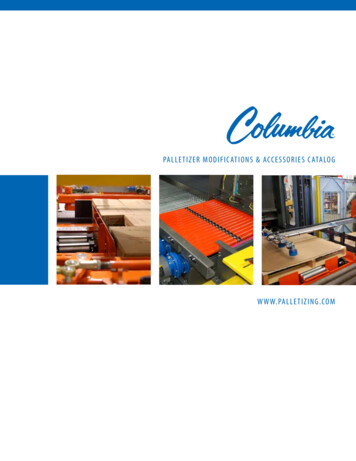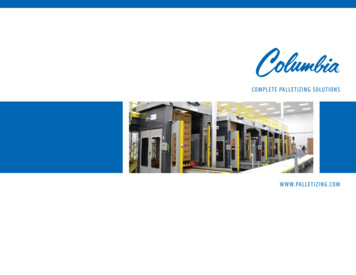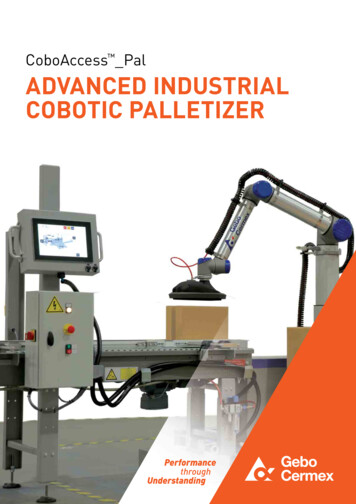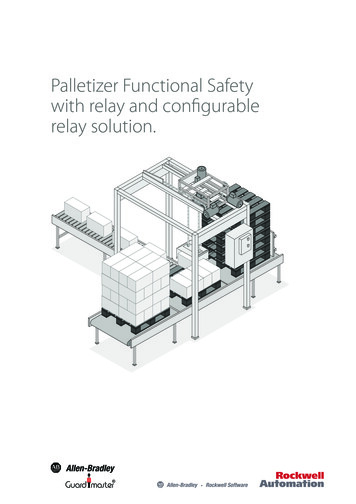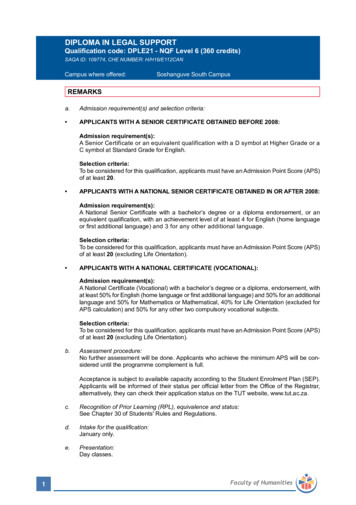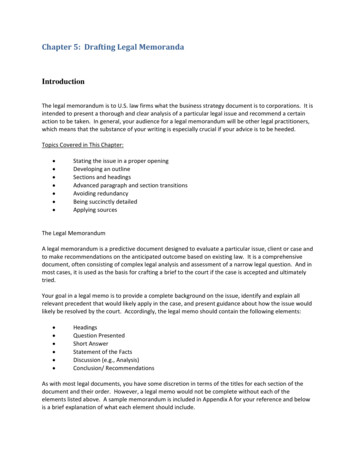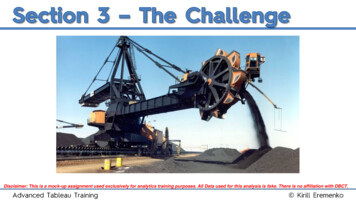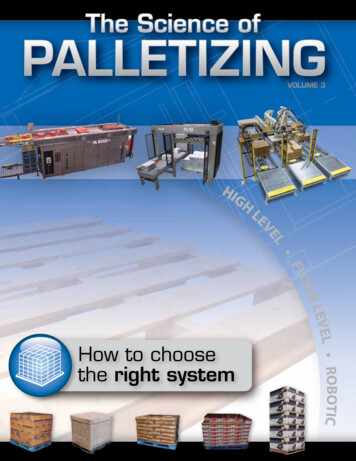
Transcription
ForewordThe Science of Palletizing is an educational introduction to the basics of unit-load forming and is designedto familiarize you with the fundamentals of palletizing. Since all palletizing applications are unique, selectinga machine to meet your specific needs cannot be done by simply reading this book. However, theinformation covered should prove to be an essential tool in the selection process.This book includes updated information from the three previous publications: The Science of Palletizing,How to Pick the Right System, and The Science of Palletizing, Volume Two – Systems. These versions werefirst released in 1987, 1988 and 1999 and were enthusiastically received by the material handling industrywith over 52,500 copies being circulated. In this edition, updates on the latest trends in conventional androbotic palletizing, palletizer accessories, multiple line solutions and tips on how to select the right systemare all included.The Science of Palletizing is organized by chapters allowing the reader to identify the topics of most interest.Because of this, there is some information repeated throughout the book to ensure that a completeoverview is presented. For example, conveyors are discussed in length in the Conveyors chapter and again inthe Robotic Palletizing and Conventional Palletizing chapters as conveyors pertain to each of thosesolutions.If you have additional questions not covered in this publication or a specific application for which yourequire assistance, visit www.palletizing.com, fill out the postage-free reply card at the back of the book orcall toll free at 800-628-4065 or direct at 360-694-1501. We will be happy to assist you.Legal DisclaimerThe author and contributors to this publication have made their best effort to ensure all content is accurate; however, no guarantees are expressed or implied regarding the use of any of the equipment contained within this publication. User assumes allresponsibility for the use of any equipment detailed within this publication.The contents of this publication, including all information, material and graphics, are the copyrighted work of Columbia Machine,Inc. or third parties who have submitted their materials to Columbia Machine, Inc., and are protected by U.S. and internationalcopyright laws. The compilation of all contents within this publication is the exclusive property of Columbia Machine, Inc. is alsoprotected by U.S. and international copyright laws. This content is intended for informational use only and may not be altered inany way. Any other use including modification, reproduction, distribution, republication, display, performance, or creating derivative works of this publications content is strictly prohibited without the prior written consent of Columbia Machine, Inc.Please note: many of the drawings and photographs shown in this book do not show appropriatesafety guarding. The guards were left out for image clarity.Copyright 2009, Columbia Machine, Inc. All Rights Reserved.Written by Robin A. Popple, Major Accounts Manager at Columbia Machine, Inc.www.palletizing.com1
Table of ContentsTable of Contents134725324150545964676870ForewordTable of ContentsChapter 1: The History of PalletizingChapter 2: Common Elements of PalletizingChapter 3: ConveyorsChapter 4: Robotic PalletizersChapter 5: Conventional PalletizersChapter 6: Multiple Line SolutionsChapter 7: AccessoriesChapter 8: Now What?Chapter 9: Identifying a Palletizer to Meet Your NeedsAcknowledgements & ReferencesPalletizer Information ServicesGlossarywww.palletizing.com3
1alletizingThe History of Palletizing4www.palletizing.com
The History of PalletizingThe History of PalletizingHand stacking cases into pallet loads for storage or direct distribution has been around since the very firstpackaging lines were installed. However, as production rates increased to levels of 20 cases per minute andbeyond, an automatic means for stacking cases became necessary. This created a need for an automaticsolution, known today as the “palletizer.”Row-forming automatic palletizers were first introduced in the early 1950’s. Pallet loads were created byproduct arranging on a row forming area and pushed onto a layer forming area. This process is repeateduntil a complete layer of product is formed and placed onto the pallet, until the pallet is complete andremoved from the machine.In the 1970’s, the demand for higher speeds encouraged palletizer manufacturers to invent an in-line,continuous-motion palletizer. An in-line palletizer uses a continuous motion flow divider that guides theproduct into the appropriate location on the layer forming area until a layer is complete and placed onto thepallet.Introduced in the early 1980’s, robotic palletizers use an end of arm tool (end effector or product gripper) topick the product from a conveyor or layer table and place it onto a pallet.Both conventional and robotic palletizers can receive product at a high elevation (typically between 84” to124”) or low “floor level” elevation (typically at 30” to 36”).www.palletizing.com5
The following diagram shows the basic components of floor level, high level and robotic palletizers. Thereare relative advantages to each type of palletizing solutions that are discussed in detail later in this book.Robotic palletizerFigure 1-122High level palletizerFloor level palletizer26Figure 1-3Figure 1-2Infeed: Conveyor on a palletizer where product is orientedas required to make the patterns.Pallet Dispenser: A mechanism that can accept a stack ofpallets and discharge a single pallet upon demand.Row Former: A conveyor on a palletizer used foraccumulating oriented product in a row as part of theprocess of forming a layer.Robotic Arm: An automatically controlled manipulatorprogrammable in three or more axes.Layer Forming Area: A section of the palletizer where rowsare combined to form a layer.Pallet Station: The area where the pallet is placed.Discharge Conveyor: A conveyor capable of receiving andtransporting a palletized or unitized load of product fromthe palletizer or unitizer.Sheet Dispenser: A mechanism that contains a stack of sheetsand automatically moves a sheet from the stack forplacement under the load or between layers.www.palletizing.com
2Common Elements ofPalletizingwww.palletizing.com7
This chapter discusses common elements that arerequired with all types of palletizers. Bothconventional and robotic palletizers must alwaysconsider the following requirements: Load TypesPalletsPallet DispensingPallet ConveyingSheet TypesSheet Dispensing Package TypesPatternsSpeedWorking ConditionsSafetyLoad TypesPallet load on palletFigure 2-1Pallet load on sheetFigure 2-2Pallet load on conveyorFigure 2-3There are two basic stacking methods,“palletizing” and “unitizing”. Palletizing is whenproduct is stacked onto a pallet using apredetermined pattern configuration and a givennumber of layers. Unitizing carries out the samestacking procedure, but without a pallet. Unitizedloads may be stacked onto a slip sheet or directlyonto the conveyor (Figures 2-1, 2-2 and 2-3).PalletsA pallet is a platform that supports goods fortransportation and storage that can be moved by aforklift, pallet jack or other lifting device fortransportation within an automated system.Brief History of PalletsThe modern form of the pallet was first introducedin 1925 and was modified throughout the 1920s to1940s to create the modern 2-direction stringerpallet that is used today. The introduction of thepallet had a great impact on the rail cartransportation system; taking a 3-day event ofunloading up to 13,000 unpalletized cases down toa short 4-hour task once the cases were palletized.8www.palletizing.com
Common Elements of PalletizingPallet SizesThere are trends to move towards domestic and global pallet size standardization. In the 1960s and 70s, theUS grocery industry began conversion towards the 48” x 40” standard footprint, known today as the GMAor grocery pallet. Today, there are a total of six pallet footprints recognized by ISO 6780. Although there is atrend to standardize the pallet sizes used, there are hundreds of pallet styles used today.ISO PALLET DIMENSIONS [1]Dimensions (mm) Dimensions (Inches)Wasted Floor, ISO Container*1219 x 101648.00 x 40.003.7%1200 x 100047.24 x 39.376.7%1140 x 114044.88 x 44.888.1%1067 x 106742.00 x 42.0011.5%1100 x 110043.30 x 43.3014%1200 x 80047.24 x 31.5015.2%RegionNorth AmericaEurope, AsiaAustraliaNorth America,Europe, AsiaAsiaEurope* Wasted floor space is the excess area in a shippingcontainer where pallets cannot be placedPALLET DIMENSIONS BY INDUSTRY [2]Dimensions (mm) Dimensions (inches)Production Rank1219 x 101648 x 4011067 x 106742 x 4221219 x 121948 x 4831016 x 121940 x 4841219 x 106748 x 4251016 x 101640 x 4061219 x 114348 x 4571118 x 111844 x 448914 x 91436 x 3691219 x 91448 x 3610889 x 115635 x 45 .5Unknown1219 x 50848 x 20UnknownIndustryGrocery, many othersTelecommunications, paintDrumsMilitary, cementChemical, beverageDairyAutomotiveDrums, chemicalBeverageBeverage, shingles, packagedpaperMilitary ½ ISO container, fits 36”standard doorsRetailwww.palletizing.com9
Pallet TypesThere are two classes of pallets: stringer pallet and block pallet and three main types of pallets: two wayentry pallet, partial four way entry pallet and full four way entry pallet. Within each type there are manystyles of pallets identified including: single deck, double deck, single wing, double wing, flush, singlecantilever, and double-cantilever. [3]10www.palletizing.comWinged palletFigure 2-4Stringer palletFigure 2-5Block palletFigure 2-6Nested palletFigure 2-7Four way palletFigure 2-8Two way palletFigure 2-9
Common Elements of PalletizingConstruction of Wood PalletsMost pallets have a top, middle and bottomsections. The key difference in the pallet styles ishow these three pieces are constructed. Some woodpallets only have top boards and stringers.As discussed above, there are many styles of woodpallets and these all fall into two classes of pallets:stringer pallets and block pallets. The following arethe key differences in the construction of thesepallets.Stringer pallets are constructed with top deckboards that are attached to two or moreparallel pieces (called the stringers) to create thepallet structure.Top interior deckboardCenter stringerOuter stringerStringer pallet Figure 2-10Block pallets are constructed using blocks to attachthe top deck boards to the bottom deck boards.Most block pallets are constructed using 9-blocks,although a 4-block pallet and 12-block pallets areavailable styles.Top boards create the top deck of a pallet. Theseboards can all be the same or variable width or canbe solid; they can be spaced evenly apart or joined.Bottom boards create the bottom deck of a pallet.The bottom deck can consist of 3 longer skids, apicture frame or a solid deck.The middle of the pallet is the key in determiningwhich class the pallet will fall into. If the middleconsists of long, parallel pieces then this creates astringer pallet. If the middle consists of blocks, thenthis creates a block pallet.ISPM No. 15(International Standards forPhytosanitary Measures) requires all woodpackaging material with a thickness of over 6mmthat are used to ship products between countries tobe heat treated or fumigated with methylbromide and marked with a seal of compliance inorder to prevent spreading pests. This includes allwood packaging materials such as pallets, cratesand dunnages. [4]Repaired PalletsQuite often repaired pallets are used and it isimportant to understand the pallet grade system.Pallet grades refer to the condition of repaired woodpallets and the acceptable defects of the pallet.Classes of repaired 48” x 40” notched three stringerpallets: [5]Top interior deckboard Class 1: Could contain metal plates, but nocompanion stringer repairs.BlockBottom deckboard Class 2: One or two stringers repaired usingplugs and/or notched blocks or longercompanion stringers.Block pallet Figure 2-11 Class 3: Otherwise not meeting Class 1 andClass 2 criteria.www.palletizing.com11
Other Materials UsedPallet Rental SystemsToday, pallets are made of wood, plastic, compositewood (such as plywood), paper-based (also knownas corrugate) and metal (aluminum, steel, etc). Theintended use of the pallet, required life of thepallet and the environment in which the pallet willbe placed, will determine the type of pallet needed.Prior to 1990 there were two methods of acquiringpallets for shipping. The first is purchasing newand/or used pallets to ship goods on knowing thatthe pallet will not be returned. The second, mostlyused by larger manufacturers, was individual “poolsystems” that allowed the manufacturer to receivetheir pallets back to be used again.Slab Pallets are a solid plywood board (sometimesplastic) usually between 7/8” and 1 1/8” thick. Sizesvary; common dimensions include 40” x 48” and 43”x 51”.Slab pallet Figure 2-12Plastic Pallets come in many different styles, sizesand materials. Some plastic pallets mimic theconstruction of wood pallets while others, suchas one piece molded pallets or nested pallets, areunique.Plastic pallet Figure 2-13Pallet ConditionWith the wide variation of pallet conditions for anautomatic palletizer, it is extremely important tohave a pallet inspection program in place to identifypallet defects. These defects may include protrudingnails, broken boards, poor repairs, mold andmissing bottom boards. These flaws may causepallet jams or other problems that may createpalletizer downtime or may even damage yourproduct prior to shipping. In place of a palletinspection program, some companies choose toparticipate in a Pallet Rental or Management Systemas follows.12www.palletizing.comIn 1990, a National Pallet Rental Pool Program wasintroduced in the U.S. by CHEP after successfullyimplementing similar programs around the world.A pallet rental or management company suppliespallets to a user company in the supply chain. Theadvantage to participating in this program is that itis less expensive to “rent” a pallet than to purchase apallet. However, the rented pallets must stay withinthe pallet pool and be returned to the rentalcompany or the user company will receive anadditional charge for the pallet. Whenconsidering using a rental pallet company, it isimportant to consider the type of pallets needed,the needs of your business partners and tofamiliarize everyone in your company and yournetwork of retailers and logistics operators of yourplan to use rental pallets in order to make it asuccessful program.[6] Today, there are many palletrental companies; some of the largest include CHEP,iGPS, PECO, Kamps Pallets and CPC (Canada).Pallet DispensingA pallet dispenser takes a stack of pallets andseparates one pallet out to convey into thepalletizer.Pallet Dispenser TypesThere are many different types of pallet dispensersin order to handle the various styles of pallets. Thethree main types of pallet dispensers are: StripperStyle with Pallet Hopper, Lift & Separate with PalletHopper and Staging Pallet Dispenser.
Common Elements of PalletizingStripper Style with a Pallet HopperA pallet stack (usually 12 – 19 high) is placed intoa hopper with the stack resting on two elevatedpads slightly above the two chains. When thedispenser is placed in motion the lugs on thechain push the bottom pallet through a nominal7” opening in the front of the wall with the upperstack restrained by the front wall.(Figures 2-14a and 2-14b)Lift & separate with pallet hopper Figure 2-15aStripper style with pallet hopper Figure 2-14aLift & separate pallet dispenser isometric view Figure 2-15bStripper style pallet dispenser isometric view Figure 2-14bLift & Separate with Pallet HopperPallets are placed into a hopper (usually 12 – 19high) where the pallet stack is resting on a liftmechanism. A lift mechanism raises the stack sothat a holding mechanism holds the pallet stackfrom the second to bottom pallet. The liftingmechanism lowers the bottom pallet onto thechains or rollers and dispenses into the palletizer.(Figures 2-15a and 2-15b).www.palletizing.com13
Staging Pallet DispenserA pallet stack (12 – 19 high) is conveyed into thepallet dispenser and a lift mechanism raises thestack so that a holding mechanism holds thepallet stack from the second to bottom palletleaving the bottom pallet on the conveyor. Thelifting mechanism lowers the bottom pallet onto thechains or rollers and dispenses the pallet into thepalletizer. When the last pallet in the stack has beendispensed, the system automatically conveys in thenext stack of pallets.Fork style pallet dispenser Figure 2-17aFork style pallet dispenser isometric view Figure 2-17bPallet ConveyingThere are many types of pallet conveyors used intransporting a pallet load of product including:roller, chain, plastic belt and slat (Figures 2-18 2-22). For more sophisticated lines, AutomaticGuided Vehicle (AGV), Laser Guided Vehicle (LGV)and transfer cars are used.Staging pallet dispenser with pallets Figure 2-16In both the Lift & Separate and the Staging PalletDispensers lifting mechanisms are used. There aremany kinds of lifting mechanisms. The liftmechanism can be a scissor lift, air bags, electricmotor or air cylinder between the chains. Theholding mechanism can be steel plates that swingdown or swing in to hold the pallets by the outerboards or can be fork lift style. All of these areconsidered a lift and separate style. A variation ofthe lift and separate, with a holding mechanism forthe side boards, is the Fork-Tine Style PalletDispenser. This is where two steel plates, similar tofork lift tines, run the full breadth of the pallet.14www.palletizing.comChain driven live roller conveyor Figure 2-18Gravity roller conveyor is the least expensive ofdischarge conveyors. However, it’s notrecommended for extra high loads or highcolumn-stacked loads. Also, a length of 15 feet isconsidered maximum.Belt-driven live roller and chain-driven live roller(CDLR) are the most common types of dischargeconveyors. They are used when the pallet bottomboards are traveling perpendicular to the rollers.When used in five-foot sections, these conveyorscan stage loads into a stretch wrapper or onto ashuttle car.
Common Elements of PalletizingIf the pallet bottom boards are parallel to thedischarge rollers, they can lead to excessivevibration as the pallet travels over the rolls. Thenumber of bottom boards also becomes critical indetermining whether the pallet can travel along thedischarge conveyor without shaking the load apart.A full load discharge conveyor with close-centeredrollers can eliminate some of the vibration. But thenumber and size of the bottom boards, diameter ofthe rollers and the roller’s center to centerdimension must be considered.A two or three-strand chain conveyor is thepreferred method of handling pallet loads whenthe bottom boards are running the perpendicularto the direction of travel. The slat conveyor is alsoan option because its surface is flat and capable ofconveying full pallet loads both with and withoutpallets.Slat conveyor Figure 2-20Unitized loads of product that could sag betweenrollers or when the product is light weight, small orhas an irregular shaped bottom are best transportedon a plastic belt conveyor.Plastic belt conveyor Figure 2-21Chain pallet conveyor Figure 2-19Challenges of Pallet Dispensing & ConveyingA key challenge to any automatic system is thequality of the pallets. Loose bottom boards,protruding nails that scrape and missing top boardson the outer edge may create a jam requiringmanual intervention.www.palletizing.com15
Sheet TypesSlip sheets, deck sheets, tie sheets and cap sheetsare frequently used for a variety of reasons. Some ofthe reasons include protection from moisture,adding load stability, or protecting the load fromenvironmental elements. Sheets are made frommany different materials including: corrugate(usually 1/8” thick), liner board, fiberboard or plastic.Depending on the purpose of the sheet, there is amaterial to meet your need.Cap sheet on top of pallet load Figure 2-24Slip sheets on pallet or conveyor for unitized load Figure 2-22Freezer sheets: used to separate Figure 2-25layers to allow even cooling of productTie sheet or tier sheet between layers Figure 2-23Trays, lid and corner boards Figure 2-2616www.palletizing.com
Common Elements of PalletizingSheet DispensingMost sheet dispensers have the common elementof working by suction cups via venturi system, usingcompressed air or by vacuum; creating a vacuum inthe vacuum cup and picking up a sheet.There are six types of sheet dispensers:Lift truck with push pull attachment Figure 2-27Slip SheetsThe primary purpose of slip sheets is for pallet-lessload building (unitizing) and requires the use of apush pull attachment (Figure 2-27) on the lift truck.A slip sheet placed on a pallet (Figure 2-22) acts asan extra layer of protection for the product.Deck SheetsIn general, deck sheets measure equal to or slightlyless than the top surface of a pallet. Deck and tiesheets can be used in similar situations.Floor level slip sheet dispenser Figure 2-281. Floor Level Slip Sheet Dispensers – This sheetdispenser is designed to take a sheet off of a stackand move to a single elevation, such as onto a palletor roller conveyor for unitizing.Tie SheetsWhile rectangular cases may be interlocked toprovide stability, square cases can only be columnstacked. Tie sheets can be automatically insertedbetween pre-selected layers to improve stability(Figure 2-23). They are generally used withcolumn-stacked loads, square cases, display packsor when many cases (20 or more) must be layered.Cap SheetsA cap sheet is used to protect the top of a load andis placed while still in the palletizer or at a positiondownstream, such as in the stretch wrap machine(Figure 2-24).Floor level tie & cap sheet dispenser Figure 2-292. Floor Level Tie and Cap Sheet Dispensers - On afloor level palletizer the sheet dispenser is designedto raise a sheet to successively higher layers.www.palletizing.com17
High level sheet dispenser Figure 2-303. Sheet Dispensers on High Level Palletizers – Thissheet dispenser is located on the top of the machineto place a sheet on the pallet and between layersbecause the load is always raised to the top of themachine.Dual hopper sheet dispenser Figure 2-325. Two Sheet Sizes – Two sheet sizes can be handledin one sheet dispenser by using a dual hopper sheetdispenser.Robotic sheet placement Figure 2-33Bulk loading sheet dispenser Figure 2-314. Bulk Load vs. Hand Stack – Bulk load allowsloading a pallet load of sheets into the sheetdispenser using a fork lift. Hand loading requires asmaller stack of sheets to be manually placed intothe sheet dispenser.18www.palletizing.com6. Robotic Applications – A robotic end effector canbe equipped with a sheet handling tool that whencombined with a sheet table allows the robot toplace the sheets onto the pallets or layers asneeded. This adds tremendous versatility and cansave the cost of buying a sheet feeder, but it does soat the cost of overall speed.
Common Elements of PalletizingSome Common Challenges of Sheets1.Too much static electricity can causemultiple sheets to be picked.2.Extremely porous sheets allow multiplesheets to be picked.3.Used sheets can cause problems due toinconsistent sheet placement in the stackand lower quality sheets.4.Freezer sheets with a waffle pattern canmake it difficult to create a vacuum.5.Ungraded sheets are not controlled (materialcomposition and thickness).Package TypesToday there are many different types of packagesthat require palletizing, including traditional RSC,shipper case, bundle wrapping, shrink wrapping,display packs, bags, trays, totes, over wrapping trays,plastic full depth tray (milk crate), small cases andplastic beverage trays.DefinitionsRSC – Regular Slotted Case, typically corrugate case.RSC Figure 2-34Package TypesThe packing of goods into a container, such as acase, bag, wrap, etc.Packaging TrendsEvolution of package types has changed drasticallyover the last decade moving from the use of shippercases to minimal packaging material and smallercases. Palletizing traditionally was done on RSCand corrugate boxes, which was a heavy materialto protect the individual retail packs for display onthe shelves. Today, marketing requirements, retailoutlets (such as club stores), green considerationsand economical constraints are driving a revolutionof packaging types.Bundle wrapping – A flexible-film option forheavier and larger multipacks of two or more unitsthat offers a surface for high-impact graphics,using primarily print-registered polyethylene film.Film thickness is 1 mm to 1.5mm and provides thestrength needed for package carrying.Bundle wrapping Figure 2-35www.palletizing.com19
Shrink wrapping – A flexible-film option preferredfor multipacks ranging from two bottles to even a36 pack of bottled beverage. Film thickness is.45 mm to .75mm and requires trays, inserts or padsto enhance package strength.Shrink wrapping Figure 2-36Display cases – A corrugate case where the top isopen, and the sides may be partially open.Display casesPackaging Challenges for Palletization1. Smaller package footprint, traditional case sizewas 16” x 12” now product is as small as 4” x 6” andcan be stacked using automatic palletizers.Small footprint packages Figure 2-392. HCG (High Center of Gravity) includes cases thatare relatively tall with a small footprint. The generalrule for determining a HCG is when the height ismore than 1½ times the products width. Examplesof HCG packages include some bag in a boxproducts or (3) ½ gallon cartons of milk bundledtogether as shown below.Figure 2-37Trays – Trays can be corrugated, plastic and atvarious heights.HCG cases Figure 2-403. Extra large package footprint, cases are now upto 36” x 24” or larger.Trays Figure 2-38Extra large footprint packages Figure 2-4120www.palletizing.com
Common Elements of Palletizing4. Graphics on the package are no longerprotected by a “shipper case” requiring gentlehandling of the primary package.Column stack Figure 2-44Interlock stack Figure 2-43Packaging with graphics Figure 2-42PatternsThe number of case patterns that can beprogrammed into a fully automatic palletizer isvirtually limitless, using today’s range ofprogrammable controls and software. However,when a pattern is programmed into the palletizer, itis not simply a software change in theprogrammable controller itself. In some cases,mechanical adjustments to case stops, layer guides,etc. are required. Today’s technology makes itpossible for these changes to be done automaticallythrough the use of a HMI (Human MachineInterface).Traditional patterns: interlock and columnThere are two basic types of patterns: interlockedand column stacked. Interlocked patterns arecreated with rectangular packages that enable thepalletizer to create a load that has each layerrotated 180o for interlocking purposes. In this waya very stable load is built (Figure 2-43). Columnstacked loads can be created with packages whereinterlocking cannot occur (Figure 2-44).Interlock and column stack loads Figure 2-45Some case sizes do not allow the patterns to beconfigured without gaps in the pattern either sideto side (Figure 2-46) or front to back (Figure 2-47).Most palletizers have the ability to create patternswith these gaps in both directions (Figure 2-48).Side to side gaps Figure 2-46Front to back gaps Figure 2-47Gaps in both directions Figure 2-48www.palletizing.com21
Mixed Pallet LoadsPallet loads have traditionally consisted of one SKU.Pallet loads with two or more SKUs, mixed palletloads, are becoming more popular due to threecommon trends that occurred over the past15 years. The first trend is retailers are placingsmaller, more frequent orders to make better use oftheir floor space. The second trend is club storesdemanding “shoppable” display ready pallets withminimal waste and a desire to reduce in-store laborcosts.2. Mixed layer pallets are created to meet storerequirements of limiting the amount of inventoryin the back rooms. This pallet load is similar to thedisplay pallet where all of the package sizes are thesame; however, this pallet load may have a layer anda half of cola, layer and a half of diet, partial layer ofgrape and a partial layer of lemon lime, all palletizedto order.There are three common types of mixed palletloads:1. Display pallets, also known as rainbow pallets,are when every package size is the same but withdifferent SKUs. This was first seen in the beverageindustry where each layer or column is made up ofa different flavor of beverage. For example, the firstcolumn (or layer) was cola, the second diet, the thirdgrape and the fourth lemon-lime.Mixed layer pallet Figure 2-503. True mixed pallet loads (order picking) are alsocreated to meet store requirements, as in the aboveexample; however, this pallet load contains a varietyof case sizes from a variety of manufacturers. Forexample, a true mixed pallet load may contain a halflayer of cola, a half layer of diet cola, a half layer oftoothpaste, a half layer of shampoo, a full layer ofpaper towels and a full layer of chips.Display pallet Figure 2-49True mixed pallet Figure 2-5122www.palletizing.com
Common Elements of PalletizingMixed load palletizing can be done at themanufacturers’ plant, regional distribution centersor third-party logistics provider locations. Laterchapters of this book will discuss how both roboticpalletizers and conventional palletizers haveadapted to create mixed pallet loads.SpeedGenerally, when speeds are discussed for a givenpalletizer; they are based on a 10 case per layerpattern configuration. A fully automatic, low speedpalletizer will operate at a rate as low as 5 cases perminute (10 cases per layer, five layers). On the upperend of the speed range, some palletizers can handle150 to 200 cases per
Robotic palletizer Figure 1-1 Floor level palletizer Figure 1-2 High level palletizer Figure 1-3 The following diagram shows the basic components of floor level, high level and robotic palletizers. There are relative advantages to each type of palletizing solutions that are discussed in detail later in this book.
